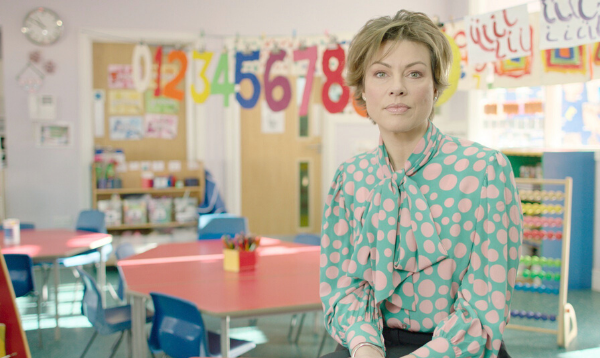How Scotland’s public health approach to tackling violence is reaping rewards
Journalist, broadcaster and Place2Be trainee Kate Silverton shares insights from her compelling BBC Panorama report on Scotland’s Violence Reduction Unit.

Stephen Rae, now 32, was eleven years old when he got caught up in gang violence on the Easterhouse estate on the outskirts of Glasgow. Still one of the most deprived areas of the UK, at one point there were 55 gangs terrorising its streets. “If someone came towards you,” he tells me, pointing to a school playing field “and they were pulling out a knife and you didn’t have one, you knew you had to run or else you might die.”
I met Stephen during filming for a Panorama looking at Scotland’s innovative public health approach to fighting violence and gang crime through its Violence Reduction Unit (VRU), set up in 2005. Its success has garnered interest from London and elsewhere in the UK, as well as from the World Economic Forum.
Sustained by long term investment, Scotland’s VRU has reduced homicide rates in Glasgow by more than two thirds and violent crime overall by more than 35%. Scotland’s old gang culture has all but been eradicated and countries around the world, including South Africa and Sweden, are taking note. Across England and Wales 18 VRUS have been set up as a result.
The personal testimonies I heard from young offenders, ex-cons, teachers, police and the medical profession about the personal and public cost of youth violence were hair-raising.
For the kids in the gangs Stephen was part of as a youngster, violence was normalized and something that they attributed to the hard men of Glasgow culture. The success of VRUs, which treat violent behaviour as a disease and seek to find a cure for it, lies in placing childhood trauma at the heart of their public health policies and practice. Everybody, from police officers and lawyers through to teachers, are given training and made aware of how adverse childhood experiences if left unresolved, can lead to disruptive and violent behaviour.
The VRU understood to tackle the root causes of violent crime it needed to not just be a criminal justice issue but something much broader to be tackled collaboratively with other bodies such as education, health and prisons. During my conversations it became clear to me that it is this “joined up” multi-agency approach that underpins the achievements of VRUs. But my documentary is also a cautionary tale. It's a stark portrait of how austerity fuels social unrest and violent behaviour. The rise in violent crime in Scotland in the past few years as a result of austerity and deepening social inequality can be seen as a call to arms.
“The gap between rich and poor has become wider,” says Niven Rennie, director of Scotland’s VRU. “Numerous studies have shown that when the gap becomes wider, violence goes up.” In England and Wales, knife and offensive weapon crimes involving young people aged 10- 17 have been rising year on year, from 2,639 in 2013 to 4,562 in 2019.
VRUs recognise that, when it comes to violence or social unrest, parents are part of the solution – they are the “magic,” according to SVRU co-founder Karyn McCluskey. Stephen, an active member of Oakwood Primary School where his daughter is a pupil, is proof of that. As we were talking, he pointed to a group of dads– “the boys we fought with,” he called them, “their kids come to this school. We talk to each other now because the way we looked at it, we only ever fought because that was the normal thing to do”. Violence is no longer seen as the only option for many in his community.
Parents, like children, need professional support to work through the Adverse Childhood Experiences (ACEs) that threaten a perpetuation of intergenerational violence.
Heather, a single mother of nine children, has benefitted from counselling for the last year and a half with Place2Be. She is now an active member of Oakwood Primary’s after-school family club. The counselling, she told me, “changed my life, which then meant it changed [my children’s] lives because I became a better mummy.” Some of her children join her for the club’s evening meal. “We sit around the table and have dinner. That’s important.”
“It’s no longer a ‘lock 'em up and throw away the key’ approach, but a mindset that says: we are going to give people an opportunity, we are going to give people the equality that they’re looking for.”
Former armed robber and heroin addict Kevin Neary is a beneficiary of that compassionate approach to reducing violent crime, and is now helping others to live a life away from crime.
“Part of the revolving door of prisons is that people have a dream to come out of prison and not re-offend again,” says Kevin. “They come out and get caught up in the same stuff again – and go back into prison.”
Kevin draws a direct line between his own experiences of childhood poverty and trauma and the endless prison sentences he served. Prison, he says, was “a horrible experience. I always said I would never go back but I did. I was part of the revolving door.”
Developmental psychologist Dr Suzanne Zeedyk is adamant that enabling an offender to tell their life story is crucial if that person is to understand the ACEs that shape their behaviour – and how to move away from that behaviour.
“Kevin wasn’t expected by his teachers to amount to much,” says Zeedyk, who now works with Kevin to communicate the importance of early years trauma to agencies. “They were right. He was in prison by the time he was 17. What the teachers didn’t know to think about was the levels of domestic violence, poverty and fear that he was going home to. “What they saw as bad behaviour was actually stress and fear. It was only in his 50s that Kevin came to understand how much those childhood experiences had shaped his life story”.
For many of the young people I spoke to as part of this documentary, the message I heard was the same. Jordan (not his real name), mentored by Kevin Neary as part of the VOW project after leaving Scotland’s Polmont Young Offenders Institution, told me, “I feel like it took me to go to prison and come back out to get that support”.
If, as a result in particular of the Coronavirus crisis, the Government makes budget cuts as a result of rising levels of debt and stops investing in VRUs, my findings for this week’s Panorama may serve as a portent of things to come.
No one, not least the victims of violence, want to see violent crime increase. Might it be time then to consider Scotland’s radical, more compassionate approach? Might we consider the role we each have to play in society and take a new direction of travel with a change in narrative that sees those involved in crime better understood. It might result not just in huge criminal justice savings further down the line, but all importantly, in saving lives too.
Panorama: How Scotland Cut Violent Crime is available to watch on BBC iPlayer.
Twitter: @Katesilverton
Www.katesilverton.com
Read more about our work in Scotland.
This blog was written in a personal capacity and does not necessarily reflect the view of the organisation.




